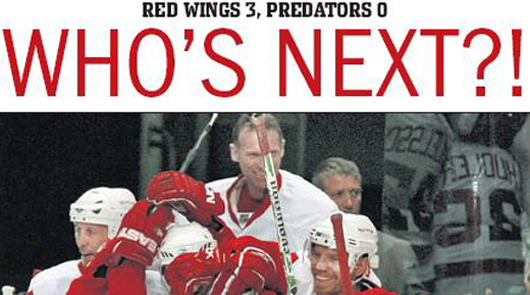
Browsing through the Newseum's front pages yesterday, I noticed the either deft or dimwitted use of the interrobang on the front page of the Detroit Free Press.
 Ideally, the interrobang is formed by visually blending a question mark with an exclamation point, as you see to the left. Few pagination and word processing programs allow such blasphemy, so we must settle with side-by-side marks of punctuation whose usages are merged. I'll call it a "severed interrobang." OK?!
Ideally, the interrobang is formed by visually blending a question mark with an exclamation point, as you see to the left. Few pagination and word processing programs allow such blasphemy, so we must settle with side-by-side marks of punctuation whose usages are merged. I'll call it a "severed interrobang." OK?!There are three common uses for an interrobang:
- To excitedly pose a question
- To convey excitement or disbelief through a question
- To ask a rhetorical question.
Its origin has been traced to media advertiser Martin Speckter, who supposedly invented it as a convenient way to express incredulity.
I suspect its frequent usage today in our sacred English language is another casualty from the slaughter that electronic communication has committed. How many times have you seen your instant messaging buddy respond to you like this:
WHAT?!?!?!
My problem always is deciding which order the question mark and the exclamation point should be arranged in. The question is: Which is the most important mark of punctuation? The first? Or the last?
I'm guessing it's the last because that's the one that makes the lasting impression, the punctuating cherry on the top. In the case of this headline, it's an exclamatory cherry.
The question mark says, "Seriously, who's next? I wanna know so we can start watching film."
The exclamation point says, "Grrr, who's next? Who wants a piece of me? Bring it on!"
Of course, the severed interrobang flies in the face of the old rule that a sentence should end in a single piece of punctuation. Sentences that end, say, with a interrogatory title cannot escape that rule's jurisdiction. Example:
- I used to watch "Where in the World is Carmen Sandiego?"
- I used to watch "Where in the World is Carmen Sandiego?".
But what would happen if the headline had just one of those punctuation marks?
WHO'S NEXT?
- Borrrrrrring.
- Wrong.
After all, the use of punctuation, as opposed to grammar, always has been somewhat interpretative. Even The Associated Press admits this. Its stylebook says: "The punctuation entries in this book refer to guidelines rather than rules. Guidelines should not be treated casually, however."
But let's remember that the person who invented the interrobang worked in advertising. So putting it in a front-page headline is not just melding two marks of punctuation; it's also combining news and advertising.
A simple punctuation mark, the interrobang, could be responsible for the fall of the wall between church (advertising) and state (news).



4 comments:
I think interbangs are cheesey, but what do I know?!?!
What are interbangs?
Clever usage of the interrobang at the end of that sentence, though!???!!>@#$^%@#$%^$&^
A simple punctuation mark, the interrobang, could be responsible for the fall of the wall between church (advertising) and state (news).
You really think addys get church? And we're state? I suppose if you consider the church of consumerism (and Rev. Billy, on the other side), then you might be right.
~WN
I thought about that before I posted, and I didn't look it up on the Google before posting because I have my own beliefs.
News follows strict, secular-type rules, for the most part. We're bound to serving the people and to making decisions that benefit the people. Much like the government.
Advertising people can put forward any belief they wish. And what they believe in is developed from information that supports that belief. Their decisions and the products they believe in aren't necessary what's best for all the people; there are many in their audience who will dissent. Much like religious sects.
Post a Comment